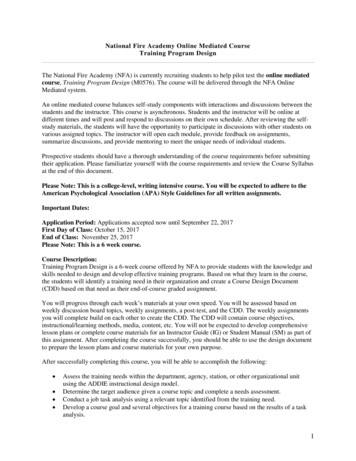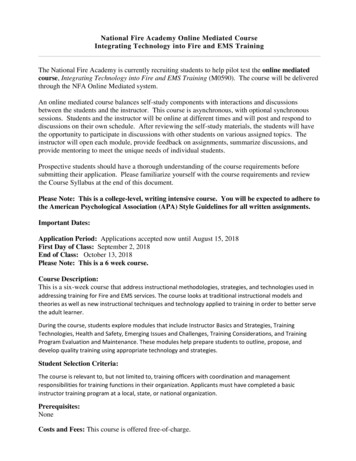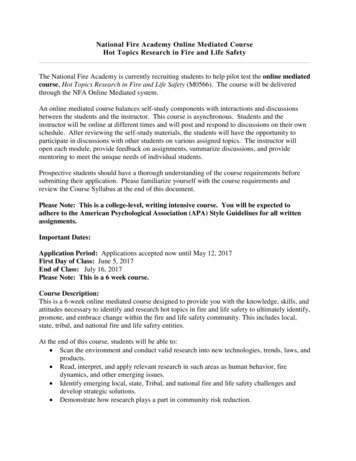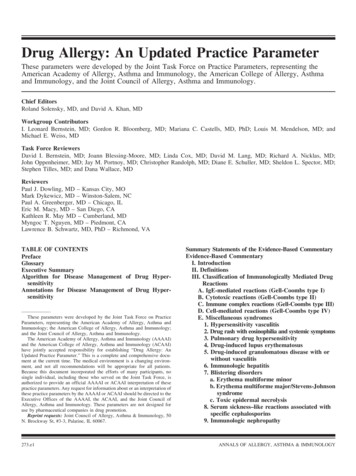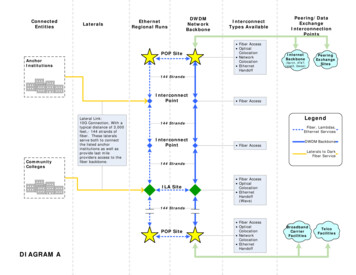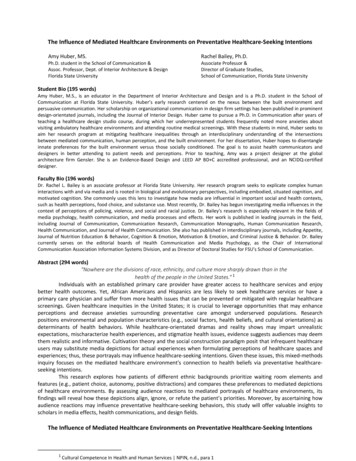
Transcription
The Influence of Mediated Healthcare Environments on Preventative Healthcare-Seeking IntentionsAmy Huber, MS.Ph.D. student in the School of Communication &Assoc. Professor, Dept. of Interior Architecture & DesignFlorida State UniversityRachel Bailey, Ph.D.Associate Professor &Director of Graduate Studies,School of Communication, Florida State UniversityStudent Bio (195 words)Amy Huber, M.S., is an educator in the Department of Interior Architecture and Design and is a Ph.D. student in the School ofCommunication at Florida State University. Huber’s early research centered on the nexus between the built environment andpersuasive communication. Her scholarship on organizational communication in design firm settings has been published in prominentdesign-orientated journals, including the Journal of Interior Design. Huber came to pursue a Ph.D. in Communication after years ofteaching a healthcare design studio course, during which her underrepresented students frequently noted more anxieties aboutvisiting ambulatory healthcare environments and attending routine medical screenings. With these students in mind, Huber seeks toaim her research program at mitigating healthcare inequalities through an interdisciplinary understanding of the intersectionsbetween mediated communication, human perception, and the built environment. For her dissertation, Huber hopes to disentangleinnate preferences for the built environment versus those socially conditioned. The goal is to assist health communicators anddesigners in better attending to patient needs and perceptions. Prior to teaching, Amy was a project designer at the globalarchitecture firm Gensler. She is an Evidence-Based Design and LEED AP BD C accredited professional, and an NCIDQ-certifieddesigner.Faculty Bio (196 words)Dr. Rachel L. Bailey is an associate professor at Florida State University. Her research program seeks to explicate complex humaninteractions with and via media and is rooted in biological and evolutionary perspectives, including embodied, situated cognition, andmotivated cognition. She commonly uses this lens to investigate how media are influential in important social and health contexts,such as health perceptions, food choice, and substance use. Most recently, Dr. Bailey has begun investigating media influences in thecontext of perceptions of policing, violence, and social and racial justice. Dr. Bailey's research is especially relevant in the fields ofmedia psychology, health communication, and media processes and effects. Her work is published in leading journals in the field,including Journal of Communication, Communication Research, Communication Monographs, Human Communication Research,Health Communication, and Journal of Health Communication. She also has published in interdisciplinary journals, including Appetite,Journal of Nutrition Education & Behavior, Cognition & Emotion, Motivation & Emotion, and Criminal Justice & Behavior. Dr. Baileycurrently serves on the editorial boards of Health Communication and Media Psychology, as the Chair of InternationalCommunication Association Information Systems Division, and as Director of Doctoral Studies for FSU’s School of Communication.Abstract (294 words)"Nowhere are the divisions of race, ethnicity, and culture more sharply drawn than in thehealth of the people in the United States." 1Individuals with an established primary care provider have greater access to healthcare services and enjoybetter health outcomes. Yet, African Americans and Hispanics are less likely to seek healthcare services or have aprimary care physician and suffer from more health issues that can be prevented or mitigated with regular healthcarescreenings. Given healthcare inequities in the United States; it is crucial to leverage opportunities that may enhanceperceptions and decrease anxieties surrounding preventative care amongst underserved populations. Researchpositions environmental and population characteristics (e.g., social factors, health beliefs, and cultural orientations) asdeterminants of health behaviors. While healthcare-orientated dramas and reality shows may impart unrealisticexpectations, mischaracterize health experiences, and stigmatize health issues, evidence suggests audiences may deemthem realistic and informative. Cultivation theory and the social construction paradigm posit that infrequent healthcareusers may substitute media depictions for actual experiences when formulating perceptions of healthcare spaces andexperiences; thus, these portrayals may influence healthcare-seeking intentions. Given these issues, this mixed-methodsinquiry focuses on the mediated healthcare environment's connection to health beliefs via preventative healthcareseeking intentions.This research explores how patients of different ethnic backgrounds prioritize waiting room elements andfeatures (e.g., patient choice, autonomy, positive distractions) and compares these preferences to mediated depictionsof healthcare environments. By assessing audience reactions to mediated portrayals of healthcare environments, itsfindings will reveal how these depictions align, ignore, or refute the patient’s priorities. Moreover, by ascertaining howaudience reactions may influence preventative healthcare-seeking behaviors, this study will offer valuable insights toscholars in media effects, health communications, and design fields.The Influence of Mediated Healthcare Environments on Preventative Healthcare-Seeking Intentions1Cultural Competence In Health and Human Services NPIN, n.d., para 1
2Scope and PurposeProposal(1,368 words)Ambulatory care services help ensure that patients receive screenings and immunizations thatprevent poor healthcare outcomes (Health.Gov, n.d.; O'Neil et al., 2010). Individuals with an establishedprimary care provider have better access to healthcare (Peckham et al., 2021) and enjoy better healthoutcomes (Vargas Bustamante et al., 2010). Yet, in 2015, only 64% of Hispanics and 71% of African Americanshad a primary healthcare physician, compared to 79% of non-Hispanic whites (Levine et al., 2020). Moreover,trends suggest that U.S. adults are moving away from having a primary care physician (Levine et al., 2020).This trend may be especially problematic amongst those from minority, underrepresented groups, who areless likely to seek healthcare services, visit a usual healthcare provider, and have health insurance (Chan etal., 2020; Cohen et al., 2021; Levine et al., 2020). These factors may be why Hispanics and African Americanssuffer from more health issues that can be prevented or mitigated with regular healthcare screenings (TheOffice of Minority Health, n.d.; Torres, 2018). Given healthcare inequities in the United States (Shi et al.,2013), it becomes crucial to leverage any efficacious opportunities to enhance perceptions and decreaseanxieties surrounding preventative care amongst underserved populations.Andersen's (1995) Behavioral Model of Health Services Use positions the environment andpopulation characteristics (e.g., social factors and health beliefs) as determinants of health behaviors and, byextension, health outcomes. Still, other work points to the role of cultural-orientations in influencinghealthcare utilization (Yap et al., 2021). To interrogate these connections, this inquiry focuses on therelationship between the environment, as conveyed in media portrayals, to health beliefs that influencepreventative healthcare-seeking behaviors.A body of work connects healthcare environments to human perception, behavior, and healing(Andrade & Devlin, 2015; Joseph & Malone, 2012; Ulrich, 2001). Health environments have been shown toameliorate stress (Fenko & Loock, 2014; Higuera-Trujillo et al., 2020) and impact patient engagement(Haddox, 2018). Yet, they can also exacerbate power imbalances (Liddicoat, 2020) and violate psychologicalprivacy (Haddox, 2018; Pritchett & Buckner, 2004); thus, these environments can influence approach andavoidance behaviors (Nehme et al., 2021). Cultivation theory (Gerbner et al., 1986) and the socialconstruction paradigm (Nairn, 2007) posit that those who do not visit healthcare environments may rely on2Waiting room scenes from New Amsterdam, NBC (left); Grey’s Anatomy, ABC (center); The Good Doctor, ABC (right)
media depictions to formulate perceptions of healthcare spaces and experiences. Some evidence suggeststhat media portrayals of healthcare settings are perceived to be realistic (Witzel et al., 2018) and informative(Hoffman et al., 2017). At the same time, they can impart unrealistic patient expectations (Witzel et al.,2018), mischaracterize healthcare providers and experiences (Cullen, 2012; Stanek et al., 2015), andstigmatize health issues (Goodwin, 2014). Still, little is known about how such media depictions influence thepreventative healthcare-seeking behaviors of underrepresented, minority patient populations and whetherreactions to these depictions are universal, based on innate human preferences, or socialized conditions.This exploratory research seeks to understand how patients of different ethnic groups prioritizewaiting room elements and features, such as patient choice and autonomy while waiting, and the presenceof positive distractions (see Andrade & Devlin, 2015; Ulrich et al., 2020). By assessing patient reactions tomediated portrayals of healthcare environments, its findings will reveal how these depictions align, ignore, orrefute the patient’s priorities, and how these reactions may influence preventative healthcare-seekingbehaviors via measures of affect, medical trust, and behavioral intentions. To do so, it will comparequantitative and qualitative insights from African American, Hispanic, and white, non-Hispanic women, aged20-35. This cohort was selected as only 56% of those in their 20's report having a primary care physician(Levine et al., 2020). However, this age range presents the most prolific childbearing years of women in theU.S. (Ely, 2018; Livingston & Cohn, 2010), at a time when maternal death rates are rising at disproportionaterates (Hoyert, 2022). As such, this study's findings may have a generational impact on healthcare outcomes.ContributionsIn the face of healthcare inequities in the United States, this study will examine the potentialinfluence of mediated healthcare environments on the preventative healthcare-seeking behaviors of adultAfrican American, Hispanic, and white, non-Hispanic women. This study will evaluate whether mediatedhealthcare environments align with patient priorities relative to their affective states and perceptions ofmedical trust, and, in turn, whether healthcare-orientated programming contributes to or dissuadespreventative healthcare-seeking intentions. Further, by prioritizing potential determinants of positive affectand medical trust in waiting room environments, this inquiry could contribute valuable insights to thosemaking design decisions about healthcare spaces. Consequently, this study’s findings may offer boththeoretical and practical implications that may help mitigate healthcare inequalities.Research MethodsThis exploratory research would utilize a multi-staged, sequential mixed-methods approach to garnerinsights from a traditionally hard-to-reach population (namely, those not attending college). The first stagewould begin with a survey utilizing Nehme et al.'s (2021) affect states scales to assess ideal and actualaffective states while waiting for routine appointments. Respondents would then be asked to evaluate whichwaiting room features may help them to achieve their ideal affective state. The survey would then ascertain
media consumption patterns relative to healthcare-orientated scripted, reality, and news programming, withparticipants evaluating the validity of these programs. Respondents would then assess images of mediatedhealth environments (i.e., waiting room scenes from medically-orientated media programs) based upon thatenvironment’s attendance to their stated priorities for achieving an ideal affective state. Additionally, theywould be asked to characterize the ability of these environments to engender trust in the medical providerusing that space and the likelihood that they would visit such an environment on their own accord.The second phase of data collection would involve interviews with a quota-based, purposive sampleof the survey participant population. An equal number of participants from African American, Hispanic, andwhite, Non-Hispanic segments would be invited to participate, and those representing high and low affecthealthcare discrepancy scores on the aforementioned survey. These interviews would be used to build adeep and nuanced understanding of environmental preferences and media effects by comparing mediatedhealthcare environments to idealized healthcare environments. Transcripts will be coded against priorithemes involving factors in healthcare environments that have been shown to influence perceptions (i.e.,sense of control, coherence, opportunities for socialization, and presence of positive distractions). Thesethemes would then be compared to the quantitative data.Current Status and TimelineThe project is currently in development, with instrumentalization and pilot testing underway.DatesActivitiesApril 2022Instrument Development, Pilot Testing, IRB ReviewMay – June 2022Participant Recruitment and Data Collection for Phase 1 SurveyJuly- August 2022Participant Recruitment and data collection for Phase 2September – October 2022Data AnalysisNovember-December 2022Manuscript PreparationAnticipated OutcomesThe anticipated outcomes of this research offer important implications in two main ways. First, thestudy will provide an understanding of how healthcare environments are portrayed in media spaces and howthose depictions influence the healthcare-seeking behaviors of different population cohorts, including thosefrom marginalized groups. Second, its findings will inform the efforts of those designing healthcare spaces byoffering them a better understanding of those design elements and features that elicit a positive affect,engender trust, and evoke pro-health behavioral intentions. Moreover, by comparing insights from differentdemographic cohorts, the study will help shed light on which aspects of human perception surrounding thebuilt environment are based on innate biological imperatives that transcend race/ethnicity versus thosesocially constructed.
Potential publication venuesIt is anticipated that this study’s findings can be disseminated to venues involving media effects, healthcommunication, and healthcare design, including: AEJMC Annual Conference Center for Healthcare Design Conference (National, annual, peer-reviewed conferenced) Journalism & Mass Communication Quarterly Health Environments Research and Design JournalReferencesAndersen, R. M. (1995). Revisiting the Behavioral Model and Access to Medical Care: Does it Matter? Journal of Healthand Social Behavior, 36(1), 1–10. https://doi.org/10.2307/2137284Andrade, C. C., & Devlin, A. S. (2015). Stress reduction in the hospital room: Applying Ulrich’s theory of supportivedesign. Journal of Environmental Psychology, 41, 125–134. frican American—The Office of Minority Health. (n.d.). Retrieved January 24, 2022, aspx?lvl 3&lvlid 61Chan, K. S., Parikh, M. A., Thorpe, R. J., & Gaskin, D. J. (2020). Health Care Disparities in Race-Ethnic MinorityCommunities and Populations: Does the Availability of Health Care Providers Play a Role? Journal of Racial andEthnic Health Disparities, 7(3), 539–549. https://doi.org/10.1007/s40615-019-00682-wCohen, R., Terlizzi, E. P., Cha, A. E., & Martinez, M. A. (2021). "Health Insurance Coverage: Early Release of EstimatesFrom the National Health Interview Survey, January–June 2020. Centers for Disease Control and en, K. (2012). Meaning perspectives and the effects of television portrayal of nurses on a sample of southernCalifornia generic baccalaureate nursing students: A phenomenological inquiry [Ph.D., University of NorthernColorado]. ct/B2AD8E0BCD7942E2PQ/1Cultural Competence In Health and Human Services NPIN. (n.d.). Retrieved January 25, 2022, Ely, D. M. (2018). Trends in Fertility and Mother’s Age at First Birth Among Rural and Metropolitan Counties: UnitedStates, 2007–2017. 323, 8.Fenko, A., & Loock, C. (2014). The Influence of Ambient Scent and Music on Patients’ Anxiety in a Waiting Room of aPlastic Surgeon. Health Environments Research & Design Journal (HERD) (Vendome Group LLC), 7(3), Gerbner, G., Gross, L., Morgan, M., & Signorielli, N. (1986). Living with Television: The Dynamics of the CuItivationProcess. In B. Jennings & Z. Dolf (Eds.), Perspectives on Media Effects (Vol. 20, pp. 17–40). Sage.Goodwin, J. (2014). The Horror of Stigma: Psychosis and Mental Health Care Environments in Twenty-First-CenturyHorror Film (Part I). Perspectives in Psychiatric Care, 50(3), 201–209. https://doi.org/10.1111/ppc.12045Haddox, J. C. (2018). Impact of Design on Patient Participation in Healthcare in a Rural Health Clinic in Appalachia: AQualitative Pilot Study. HERD: Health Environments Research & Design Journal, 11(1), alth Care Access and Quality—Healthy People 2030 health.gov. (n.d.). Retrieved January 24, 2022, alityHiguera-Trujillo, J. L., Llinares Millán, C., Montañana i Aviñó, A., & Rojas, J.-C. (2020). Multisensory stress reduction: Aneuro-architecture study of paediatric waiting rooms. Building Research & Information, 48(3), 12228Hispanic/Latino—The Office of Minority Health. (n.d.). Retrieved January 24, 2022, aspx?lvl 3&lvlid 64Hoffman, B. L., Shensa, A., Wessel, C., Hoffman, R., & Primack, B. A. (2017). Exposure to fictional medical television andhealth: A systematic review. Health Education Research. https://doi.org/10.1093/her/cyx034Hoyert, D. L. (2022). Maternal Mortality Rates in the United States, 2020. 5.Joseph, A., & Malone, E. (2012). The Physical Environment: An Often Unconsidered Patient Safety Tool. AHRQ PSnet.Juliá Nehme, B., Torres Irribarra, D., Cumsille, P., & Yoon, S.-Y. (2021). Waiting Room Physical Environment andOutpatient Experience: The Spatial User Experience Model as Analytical Tool. Journal of Interior Design,n/a(n/a). https://doi.org/10.1111/joid.12205
Levine, D. M., Linder, J. A., & Landon, B. E. (2020). Characteristics of Americans With Primary Care and Changes OverTime, 2002-2015. JAMA Internal Medicine, 180(3), 463. dicoat, S. (2020). The Therapeutic Waiting Room: Therapist and Service User Perspectives on the PsychologicallySupportive Dimensions of Architectural Space. HERD: Health Environments Research & Design Journal, 13(2),103–118. , G., & Cohn, D. (2010, May 6). The New Demography of American Motherhood. Pew Research Center’s Social& Demographic Trends Project. 06/the-newdemography-of-american-motherhood/Nairn, R. G. (2007). Media portrayals of mental illness, or is it madness? A review. Australian Psychologist, 42(2), 138–146. https://doi.org/10.1080/00050060701280623O’Neil, S., Lake, T., Merrill, A., Wilson, A., Mann, D., & Bartnyska, L. (2010). Racial Disparities in Hospitalizations forAmbulatory Care-Sensitive Conditions. American Journal of Preventive Medicine, 38, .026Peckham, A., Pituch, K. A., Maxfield, M., Guest, M. A., Sivanandam, S., & Doebbeling, B. N. (2021). Aging through thetime of COVID-19: A survey of self-reported healthcare access. BMC Health Services Research, 21(1), tchett, J. K., & Buckner, E. (2004). Parental Views of the Social Environment of an Outpatient Bone Marrow TransplantClinic. Journal of Pediatric Oncology Nursing : Official Journal of the Association of Pediatric Oncology , L., Lebrun-Harris, L. A., Daly, C. A., Sharma, R., Sripipatana, A., Hayashi, A. S., & Ngo-Metzger, Q. (2013). ReducingDisparities in Access to Primary Care and Patient Satisfaction with Care: The Role of Health Centers. Journal ofHealth Care for the Poor and Underserved, 24(1), 56–66. https://doi.org/10.1353/hpu.2013.0022Stanek, A., Clarkin, C., Bould, M. D., Writer, H., & Doja, A. (2015). Life imitating art: Depictions of the hidden curriculumin medical television programs. BMC Medical Education, 15(1). https://doi.org/10.1186/s12909-015-0437-8Torres, N. (2018, August 10). Research: Having a Black Doctor Led Black Men to Receive More-Effective Care. HarvardBusiness Review. rich, R. (2001). Effects of Healthcare Environmental Design on Medical Outcomes. Design and Health: Proceedings ofthe Second .Ulrich, R. S., Cordoza, M., Gardiner, S. K., Manulik, B. J., Fitzpatrick, P. S., Hazen, T. M., & Perkins, R. S. (2020). ICUPatient Family Stress Recovery During Breaks in a Hospital Garden and Indoor Environments. HERD: HealthEnvironments Research & Design Journal, 13(2), 83–102. https://doi.org/10.1177/1937586719867157Vargas Bustamante, A., Chen, J., Rodriguez, H. P., Rizzo, J. A., & Ortega, A. N. (2010). Use of Preventive Care ServicesAmong Latino Subgroups. American Journal of Preventive Medicine, 38(6), .029Witzel, K., Weitzendorfer, M., Schredl, P., Koch, H. J., & Kaminski, C. (2018). Einfluss von Arzt- und Krankenhausserienauf das Wirklichkeitsempfinden chirurgischer Krankenhauspatienten. Der Unfallchirurg, 121(12), zYap, S.-F., Lim, W. M., Gaur, S. S., & Lim, P. Y. (2021). A framework for preventive health marketing. Journal of StrategicMarketing, 1–24. https://doi.org/10.1080/0965254X.2021.2013933
BudgetPhase 1 Survey Survey Marketing Materials(i.e., Flyers with QR codes to bedistributed & displayed at localgovernment facilities, churches, &businesses)AmountFunding Source 100AEMJC GrantAEMJC Grant Survey Incentives Survey Administration 10 Amazon GiftCardUp to 290- Quantitative Data Analysis-Phase 2: Focus Group Qualitative Data Analysis-Performed on Qualtrics provided byFlorida State UniversityPerformed on SPSS provided by FloridaState UniversityPerformed on NVivo provided by FloridaState University
This research explores how patients of different ethnic backgrounds prioritize waiting room elements and features (e.g., patient choice, autonomy, positive distractions and compare) s these preferences to mediated depictions of healthcare environments. By assessing audience reactions to mediated portrayals of healthcare environments, its


